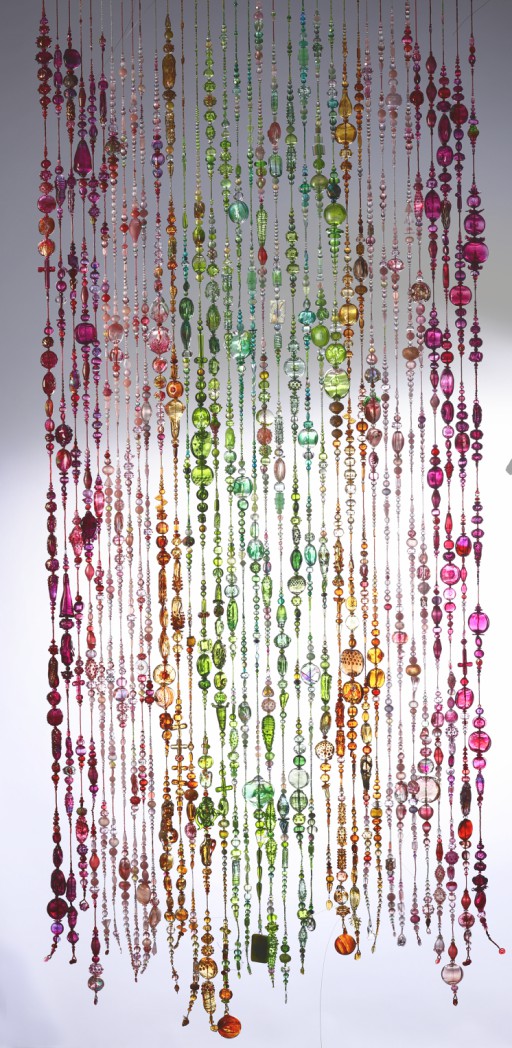‘Bead Curtain’ is the term I use for multi-strand lengths of beadwork I typically hang in windows to catch the light. Those of you who have visited butterfly houses and the like may have noticed the strands of heavy chains in doorways that serve to keep the butterflies safely inside. Originally—and perhaps still in some parts of the world—bead curtains hung in doorways, allowing people and cooling breezes through, but discouraging insects.
I didn't learn this till much later. To me, they were just yet another delightful way to incorporate beads into one's environment. I love beaded jewelry, but I tend not to wear it; so I'm always looking for other ways to enjoy beads.
Simple bead curtains, with only one or a few types of beads, strung in very regular patterns, are available commercially, but I wanted to incorporate my ideas about design and colour into mine, so they are much more time-consuming to make. Making a whole one at once would be so prohibitively expensive that I made no effort to market this product. (That said, if you would like to commission bead curtain strands, they sell for $100 per foot/30cm, with a minimum order of 2.5 feet; included in the price is a[n optional] seed-bead-strung leader up to 12"/30cm with a hand-forged copper S hook for hanging around a pole: I typically include 4–8mm beads spaced every two inches/50mm to facilitate adjustment with other strands. You can contact me at the link on the bottom of the page for more information.)

Lampwork pink and green bead-curtain, as of 2018. 35 strands, each about 6.5’ long; 18" of leader (wrapped around the pole, and fastened with hand-forged copper S hooks), plus 5’ of larger beads. Beads are mostly made by me, with additional pieces by various lampworking friends. Primarily soda-lime, with the occasional borosilicate.
But even I never attempted to make a whole curtain at once. I started the pink and green one featured on this page sometime around 2011, so the current version represents about 7 years of intermittent efforts. The following year, a woman in throes of a serious battle with cancer, decided she wanted to order a strand to mark her successful struggle against the disease: and each year, she adds another, to celebrate her continued survival: to mark the gift of another birthday.
Originally a way simply to use up a lot of low-grade beads, the curtains now represent our histories: mine document my various interests in differing lampwork techniques (or the need to brush up on a neglected one) and most especially, my relationships with other lampworkers who have given me beads I've incorporated into the curtain.

Orange, green and yellow bead curtain strands. Live area is 3’. 2012–ongoing. Sodalime glass, seed and bugle beads, Czech, Chinese and Austrian crystal; forged copper hooks and year tags. You will need to click on the image to see a truly sharp version, sorry.
Hers includes shared interests, such as henna, but particularly intertwines her friendships with neighbors, including gifts from them. So each year I try to incorporate another year of that shared history, and thus, each strand, though it relates to the others, also is unique.
Next question from those who are interested in making their own is whether I've made a pattern.
Stringing a bead curtain is not difficult, just time consuming. —If you're ever wishing to create one for yourself, I recommend the purchase of transparent Indian beads by the pound, preferably at the wholesale show. String that stuff on tigertail, because the nasty holes will eat thread alive, and 49-str is too expensive. Space it with seed beads up to 6/0 size (approx 4mm) and cheap czech.
The great thing about stringing is that if your efforts look awful, it costs you nothing but a little time to pull the beads off the tigertail and try again. Ultimately, it's in this kind of fiddling around that learn your own favorite algorithms for putting shape & color together.
If you do decide to do a curtain, figure out the length, and work on one strand at a time. Then when you've got them all done, you can arrange them on a white sheet on the floor before putting them on the curtain rod. I found that, unlike with a necklace, where everyone's looking closely, that it wasn't really necessary to match adjacent strands.
Good luck! And I'd love to see what you come up with.
Unless otherwise noted, text, image and objects depicted therein copyright 1996--present sylvus tarn.
Sylvus Tarn